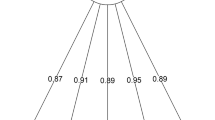Abstract
This study presents data on the norms and psychometric properties of the Beck Anxiety Inventory (BAI), using a sample of 225 community adult volunteers. Maximum-likelihood confirmatory factor analyses of previously published models of the BAI: a two-factor model and a five-factor model, showed that the fit of each model was unacceptable. Also, the fit of the single-factor model was poor. Exploratory principal-components analyses with varimax and oblique rotations suggested four BAI components within this sample. Satisfactory levels of reliability were established for the BAI subscales. Finally, the relations between the BAI total and subscale scores and a related measure of anxiety and with another self-report measure of psychological distress were examined.
Similar content being viewed by others
References
Beck, A. T., Brown, G., Steer, R. A., Eidelson, J. I., & Riskind, J. H. (1987). Differentiating anxiety and depression: A test of the cognitive-specificity hypothesis.Journal of Abnormal Psychology, 96, 179–183.
Beck, A. T., Epstein, N., Brown, G., & Steer, R. A. (1988). An inventory for measuring clinical anxiety: Psychometric properties.Journal of Consulting and Clinical Psychology, 56, 893–897.
Borden, J. W., Peterson, D. R., & Jackson, E. A. (1991). The Beck Anxiety Inventory in nonclinical samples: Initial psychometric properties.Journal of Psychopathology and Behavioral Assessment, 13, 345–356.
Cole, D. A. (1987). Utility of confirmatory factor analysis in test validation research.Journal of Consulting and Clinical Psychology, 55, 584–594.
Cyr, J. J., Doxey, N. C. S., & Vigna, C. M. (1988). Factorial composition of the SCL-90—R.Journal of Social Behavior and Personality, 3, 245–252.
Derogatis, L. R. (1983).SCL-90R: Administration, scoring and procedures manual II. Townson, MD: Clinical Psychometrics Research.
Derogatis, L. R. (1992).The Brief Symptom Inventory (BSI): Administration, scoring and procedures manual II. Townson, MD: Clinical Psychometrics Research.
Joreskog, K. G., & Sorbom, D. (1990). LISREL 7:Estimation of Linear Structural Equation Systems. Mooresville, IN: Scientific Software.
Kendall, P. C., & Grove, W. M. (1988). Normative comparisons in therapy outcome.Behavioral Assessment, 10, 147–158.
Schwartz, G. E., Davidson, R. J., & Goleman, D. J. (1978). Patterning of cognitive and somatic processes in the self-regulation of anxiety: Effects of meditation versus exercise.Psychosomatic Medicine, 40, 321–328.
Spielberger, C. D. (1983).Manual for the State-Trait Inventory (Form Y), Palo Alto, CA: Consulting Psychologists Press.
Author information
Authors and Affiliations
Rights and permissions
About this article
Cite this article
Osman, A., Barrios, F.X., Aukes, D. et al. The beck anxiety inventory: Psychometric properties in a community population. J Psychopathol Behav Assess 15, 287–297 (1993). https://doi.org/10.1007/BF00965034
Accepted:
Issue Date:
DOI: https://doi.org/10.1007/BF00965034




